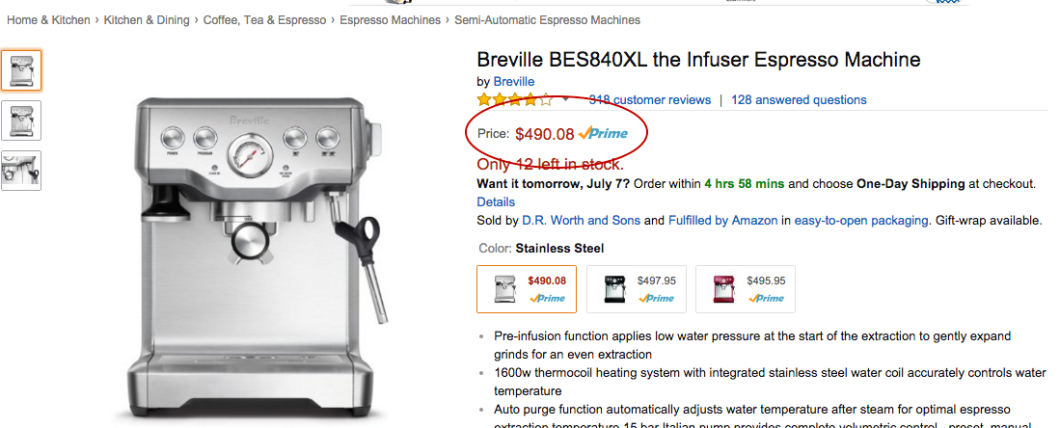Is Amazon Removing List Prices From Product Pages?
It’s a time-honored tradition in retail to show shoppers just how much a deal they are getting by showing the “list” price next to the price the customer will actually pay. It’s a practice that online sellers, who can often offer deeper discounts than bricks-and-mortar stores, frequently use, but it looks like Amazon is quietly shifting toward showing shoppers only one price.
The New York Times reports that Amazon has dropped its use of list pricing on certain items in favor of a simplified approach of showcasing the current price for the product.
Of a list of 47 items that previously showed a crossed-out list price below the current for-sale price, the NY Times found 39 now showcased just one figure.
The below Breville espresso machine had previously been advertised as selling for around $500, but with a list price of $800. Now this same machine just shows the lower price without any mention of the savings.
In other cases, the NY Times found that some of the products didn’t completely ditch the price comparison strategy, they just displayed it in a different manner. Nineteen product pages tried to encourage a sale by pointing out that the price used to be higher on Amazon, although no time period was given for that price.
Amazon’s shift from displaying discounts front and center is a stark change from what the company has been known for: a place where shoppers can find discounts on products they may pay more for in a store.
While Amazon might not be changing the actual pricing of products, failing to show just how much they are discounted could hurt sales.
“We’ve been conditioned to buy only when things are on sale,” said Bonnie Patten, executive director of TruthInAdvertising.org, a consumer information site. “As a result, what many retailers have done is make sure everything is always on sale. Which means nothing is ever on sale.”
That appears to be the case for the Breville espresso machine. While Amazon routinely shows the list price of $800 and a sale price of around $500, the NY Times points out that Breville itself sells the machine for $500.
The NY Times reports that Amazon’s move to change its pricing began nearly two months ago.
An analysis of Amazon products by comparison-pricing start-up called Rout found that in early May about 29% of the products were missing list prices. More recently that number has jumped to 70%.
It’s unclear why the retailer is making the change, but some analysts believe it could be a cautious step to avoid pricing controversies that have been highlighted in several high-profile lawsuits against other retailers related to misleading pricing practices.
Kohl’s, Kate Spade, Macy’s and Bloomingdales have all been accused, in various lawsuits, of deliberately marking up products to higher prices in order to advertise deep discounts.
We’ve reached out to Amazon about its recent pricing display changes and will update this post when we hear back.
Analysts suggest that the e-commerce company’s shift may simply be a response to changing retail preferences.
“Our data suggests that list prices are going away,” Guru Hariharan, chief executive of Boomerang Commerce, a retail analytics firm, tells the NY Times. “Amazon is a data-driven company with very few sacred cows. At the very least, it is conducting a storewide test about whether it should change its pricing strategy.”
While the change in pricing strategy may be too subtle for some shoppers to notice, those selling on the site have expressed concern over the shift.
One seller complained in an Amazon forum that the list price on his product had disappeared without notice.
“I’m well aware that it is bogus but it is a common marketing tactic that works very well at boosting sales,” he wrote.
Another seller noted that when his list prices were no longer showing up, the retailer reportedly told her they were routinely checking list prices on other sites.
Amazon Is Quietly Eliminating List Prices [The New York Times]
Want more consumer news? Visit our parent organization, Consumer Reports, for the latest on scams, recalls, and other consumer issues.


